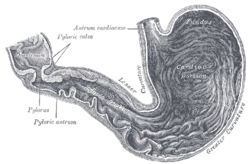Pylorus facts for kids
Quick facts for kids Pylorus |
|
|---|---|
 |
|
| Inside of the stomach (pylorus labeled at center left) | |
| Latin | Pylorus |
The pylorus is a special part of your stomach. It acts like a gate, controlling when food moves from your stomach into the next part of your digestive system, called the duodenum. The word pylorus comes from an old Greek word meaning "gatekeeper." This name fits perfectly because it guards the exit of your stomach!
Contents
What is the Pylorus?
The pylorus is the very last section of your stomach. It connects your stomach to the duodenum, which is the first part of your small intestine. Think of it as a hallway with a door at the end.
The pylorus has two main parts:
- The pyloric antrum
- The pyloric canal
The Pyloric Antrum
The pyloric antrum is the wider part of the pylorus. It's located near the bottom of your stomach and connects to the main body of the stomach. It often has a slight curve.
The Pyloric Canal and Sphincter
The pyloric canal is a narrow tube that connects the antrum to the duodenum. At the very end of this canal is an opening called the pyloric orifice.
Around this opening is a strong ring of muscle called the pyloric sphincter. This sphincter acts like a valve. It opens and closes to control how much food leaves your stomach and enters your duodenum. This helps your body digest food properly, making sure it moves at the right speed.
How the Pylorus Works
When you eat, your stomach muscles mix and break down the food. This turns it into a thick liquid called chyme. The pyloric sphincter then opens just a little bit at a time. This allows small amounts of chyme to pass into the duodenum. This careful control ensures that your small intestine isn't overwhelmed and can properly absorb nutrients.
Images for kids
See also
 In Spanish: Píloro para niños
In Spanish: Píloro para niños



